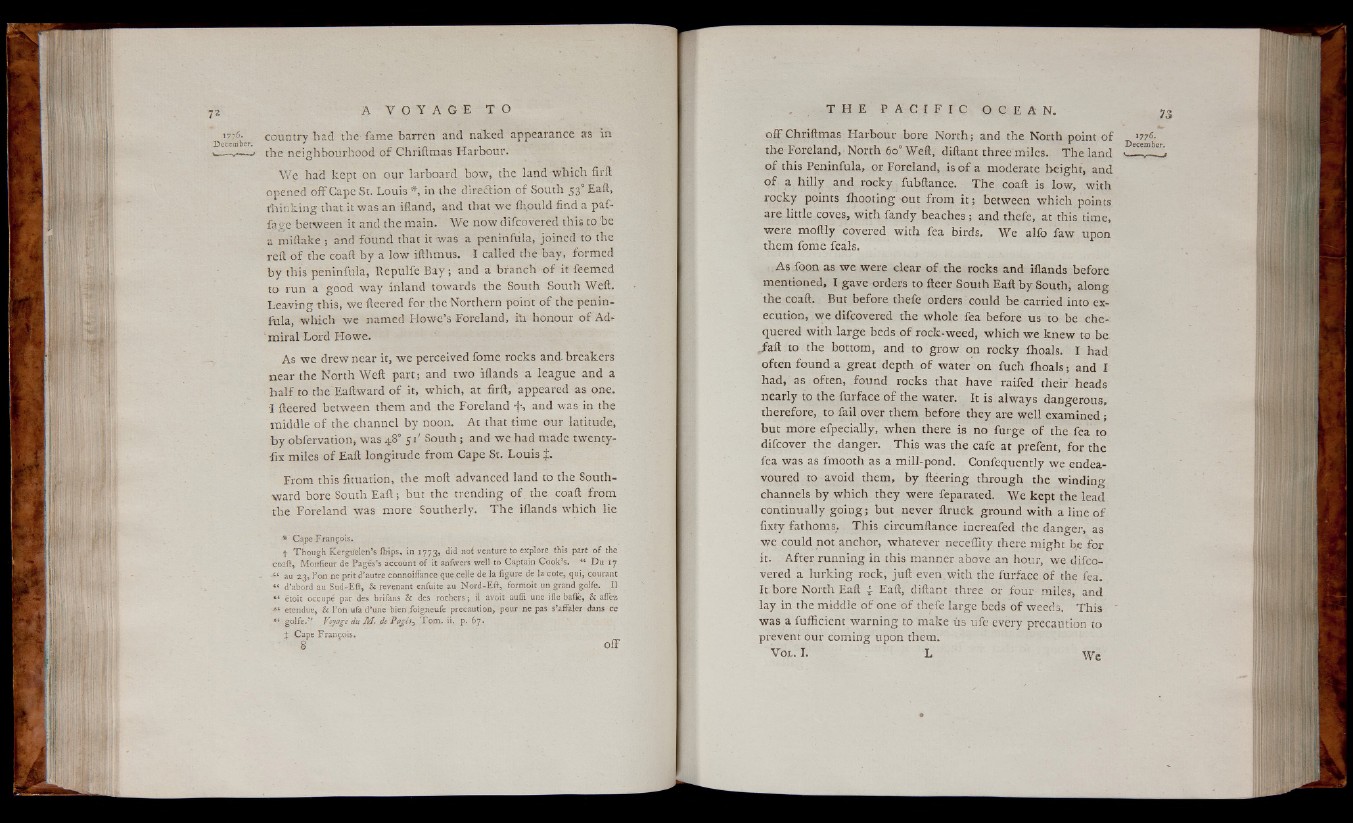
'77g- country bad the fame barren and naked appearance as in
December. J
c i v— ' the neighbourhood or Chnftmas Harbour.
We had kept on our larboard bow, the land which firil
opened off Cape St. Louis *, in the dire&ion of South 530 Eaft,
thinking that it was an ifland, and that we fh.ould find a paf-
fiwe between it and the main. We now difcovered this to be
a miftake j and found that it -was a peninfula, joined to the
reft of the coaft by a low ifthmus. I called the bay, formed
by this peninfula, Repulfe Bay ; and a branch of it feemed
to run a good way inland towards the South South Weft.
Leaving this, we fteered for the Northern point of the peninfula,
which we named Howe’s Foreland, ill honour of Admiral
Lord Howe.
As we drew near it, we perceived fome rocks and. breakers
near the North Weft part; and two iflands a league and a
half to the Eaftward of it, which, at firft, appeared as one.
I fleeted between them and the Foreland f , and was in the
middle of the channel by noon. At that time our latitude,
by obfervation, was 48° 51' South ; and we had made twenty-
fix miles of Eaft longitude from Cape St. Louis J.
From this fituation, the moft advanced land to the Southward
bore South Eaft; but the trending of the coaft from
the Foreland was more Southerly. The iflands which lie
* Cape François.
f Though Kerguelen’s flwps, in 1773, did not venture to explore this part of the
co2Ît, Monfieur de Pages’s account of it anfwers well to Captain Cook’s. “ Du 17
- au 23, Pan tie prit d’autre connoifTance que celle de la figure de la cote, qui, courant
“ d’abord au Sud-Eft, & revenant enfuite au Nord-Eft, formoit un grand golfe. Il
étoit occupe par 'des brifans & des rochers; il avait aufli une ifle baffe, .& aflez
etendue, & l’on ufa d’une bien .foigneufe precaution, pour ne pas s’affaler dans ce
“ golfe.” Voyage du M- de Pagés3 Tom. ii. p. 67.
J Cape François.
8 . off
o ff Chriftmas Harbour bore North; and the North point of >77s.
the Foreland, North 60° Weft, diftant three miles. The land . e!!m_bejj.
of this Peninfula, or Foreland, is o f a moderate height, and
o f a hilly and rocky fubftance. The coaft is low, with
rocky points ihooting out from i t ; between which points
are little coves, with fandy beaches; and thefe, at this time,
were moftly covered with fea birds. We alfo faw upon
them fome feals.
As foon as we were clear o f the rocks and iflands before
mentioned, I gave orders to fleer South Eaft by South, along
the coaft. But before thefe orders could be carried into execution,
we difcovered the whole fea before us to be chequered
with large beds of rock-weed, which we knew to be
»fiaft to the bottom, and to grow on rocky ihoals. I had
often found a great depth of water on fuch ihoals; and I
had, as often, found rocks that have raifed their heads
nearly to the furface o f the water. It is always dangerous,
therefore, to fail over them before they are well examined;
but more efpecially, when there is no furge of the fea to
difcover the danger. This was the cafe at prefent, for the
fea was as fmooth as a mill-pond. Confequently we endeavoured
to avoid them, by fleering through the winding
channels by which they were feparated. We kept the lead
continually going; but never ftruck ground with a line of
fixty fathoms. This circumftance increafed the danger, as
we could not anchor, whatever neceflity there might b.e for
it. After running in this manner above an hour, we difcovered
a lurking rock, juft even.with the furface of the fea.
It bore North Eaft i Eaft, diftant three or four miles, and
lay in the middle of one of thefe large beds of weeds. This
was a fufficient warning to make us ufe every precaution to
prevent our coming upon them.
V o l . I. L We